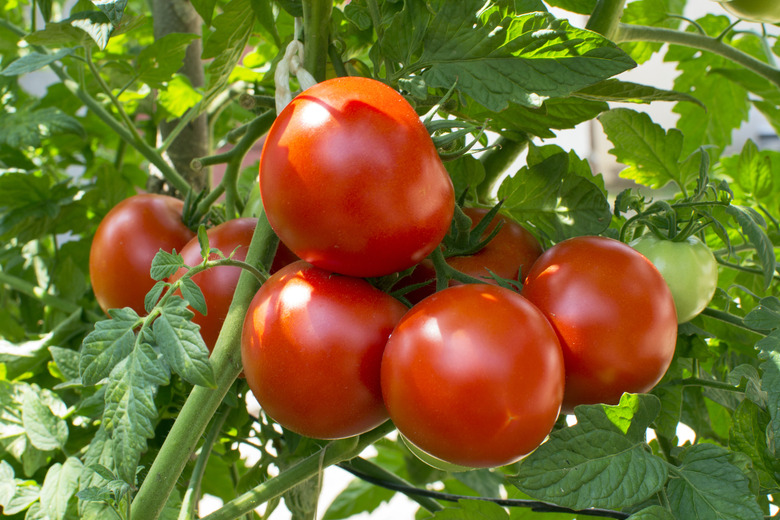How To Grow Money Maker Tomatoes
The Money Maker tomato (Solanum lycopersicum 'Money Maker,' USDA zones 10-11) is an heirloom, greenhouse tomato cultivar, hailing from Bristol, England. Money Maker tomatoes grow on indeterminate vines that reach up to 6 feet, and the fruits typically are 6 ounces, reports Rutgers. The bright-red fruits, packed with sweet, meaty flavor and texture, are almost perfectly round, with smooth, flawless skin.
Maturity takes 75 to 80 days, with vigorous production of fruit clusters. Money Maker tomato seeds are readily available through online seed retailers and may also be found at local nurseries and greenhouses, although Penn State University notes that these tomatoes primary are grown in commercial cultivation.
1. Plan the Seed-Starting Window
Start seeds at least 10 to 12 weeks before transplanting into the permanent location.
2. Fill Pots with Mix
Fill seed pots or planting trays with slightly moistened potting mix.
3. Sow the Seeds
Sow two to four seeds in each pot, at a depth of 1/8 inch, then cover lightly with moistened soil.
4. Provide Proper Light and Heat
Set seed pots on a tray and place in a location that offers full sunlight and temperatures of 65 to 80 degrees Fahrenheit, to encourage successful germination.
5. Keep Seeds Moist
Water to keep soil moist, but not soggy, during germination and early growth. Allow soil to become dry on top, then use a spray bottle to mist plants and saturate soil.
6. Thin the Seedlings
Thin out all but the strongest seedling in each pot when two to three sets of true leaves have formed.
7. Plant Seedlings in Larger Pots
Transplant established seedlings to larger pots when they reach 4 inches in height. This allows the root system to grow and strengthen without crowding.
8. Prepare the Planting Site
Prepare the permanent site approximately one to three weeks after the last frost for your area. Make certain to choose a location that offers full sun and well-draining soil. Amend soil with equal amounts of organic compost and coarse sand, incorporating a slow release fertilizer or tomato food, according to manufacturer's directions. Use a pitchfork to mix additives into existing soil then rake the site smooth to break up any existing clumps.
9. Harden Off Seedlings
Harden off seedlings by setting trays outdoors, in a mostly shady location, for several hours each day. Move trays indoors at night. Repeat this process for three to five days before final transplant.
10. Remove the Lower Leaves
Remove the lowermost leaves from each plant before inserting it into its hole. This allows roots to form near the soil surface, adding additional support to each plant as it grows.
11. Transplant the Seedlings
Create a hole for each Money Maker tomato plant, making sure it is deep enough to accommodate the existing root ball and lower portion of the established stem. Remove the tomato plant from the pot and place it into the prepared hole, then pack soil around the stem, close to the point where it branches begin.
12. Water Plants Well
Water plants to settle them into the new location and eliminate any air pockets in the soil.
13. Apply a Layer of Mulch
Apply a 2-to-3-inch layer of mulch, straw or grass clippings around the base of each plant to aid in moisture retention.
14. Provide Support for the Vines
Install a tomato cage over each plant by centering the cage over the plant and then gently pushing prongs into the soil. Providing support for these prolific plants keeps the fruits off the ground and away from hungry scavengers. Support also keeps the fruits from making contact with the soil, which can damage them.
15. Keep Plants Well-Watered
Water established plants with 1 inch of water per week. Increase watering to twice per week during periods of drought. Water tomato plants at the base, rather than over the foliage, to prevent disease and insect attacks.
16. Fertilize the Plants
Fertilize plants every two weeks during the growing season with a fertilizer that's specially formulated for tomato plants. Do not allow fertilizer directly on foliage or stems as it can cause plants to burn.
17. Prune Suckers from Plants
One of the common tomato pruning mistakes is failing to prune away suckers and side branches that form below the lowest cluster of flowers. Diligence in pruning allows indeterminate tomatoes, such as the Money Maker, to produce larger fruits at least two to three weeks earlier than those plants left to grow freely. Knowing how to stake and prune tomatoes increases the Moneymaker tomato yield per plant. Harvest tomatoes as they ripen, to encourage new fruit formation.
Things Needed
- 1. Money Maker tomato seeds 2. Seed-starting potting mix 3. Pots for starting seeds 4. Tray 5. Spray bottle 6. Organic compost 7. Coarse Sand 8. Mulch, straw or grass clippings 9. Tomato cages
- Money Maker tomato seeds
- Seed-starting potting mix
- Pots for starting seeds
- Tray
- Spray bottle
- Organic compost
- Coarse Sand
- Mulch, straw or grass clippings
- Tomato cages
